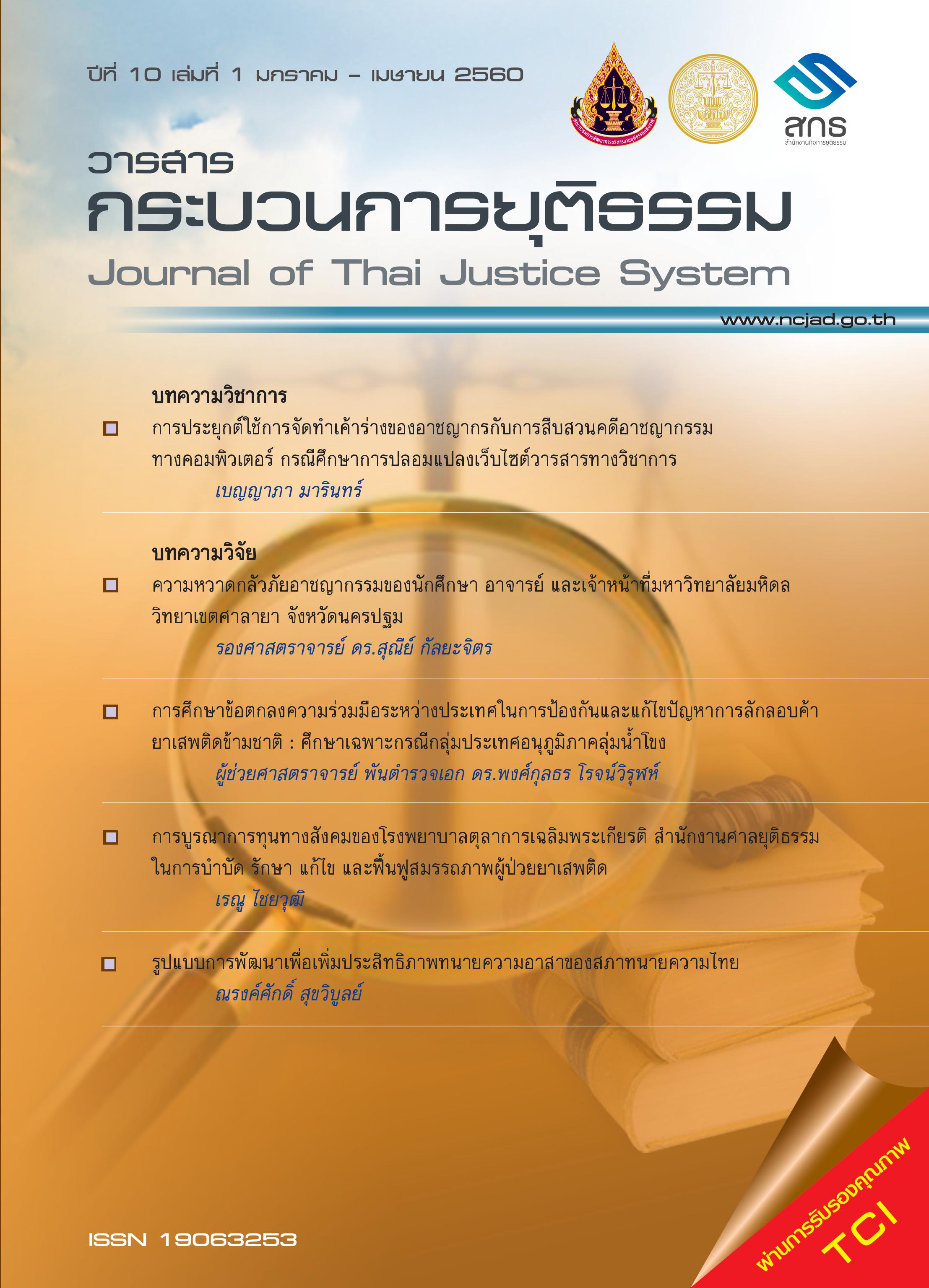รูปแบบการพัฒนาเพื่อเพิ่มประสิทธิภาพทนายความอาสาของสภาทนายความไทย
Main Article Content
บทคัดย่อ
การวิจัยเรื่อง รูปแบบการพัฒนาเพื่อเพิ่มประสิทธิภาพทนายความอาสาของสภาทนายความไทย มีวัตถุประสงค์เพื่อศึกษา วิเคราะห์และสังเคราะห์ด้วยกระบวนการวิจัยให้ได้รูปแบบในการพัฒนาเพิ่มประสิทธิภาพทนายความอาสาของสภาทนายความไทย โดยใช้ระเบียบวิธีวิจัยแบบผสมผสาน (Mixed Methodology) ศึกษาทั้งการวิจัยเชิงคุณภาพ ร่วมกับการวิจัยเชิงปริมาณ โดยการวิจัยเชิงคุณภาพใช้การสัมภาษณ์เชิงลึกกับกลุ่มผู้ให้ข้อมูลสำคัญ รวม 5 กลุ่ม ได้แก่ กลุ่มผู้ปฏิบัติงานทนายความอาสา จำนวน 10 คน ประกอบด้วย ทนายความอาสา กลุ่มผู้บริหารสภาทนายความที่ดูแลด้านนโยบาย จำนวน 2 คน ประกอบด้วย อุปนายกสภาทนายความ และหัวหน้าส่วนช่วยเหลือประชาชนทางกฎหมาย กลุ่มบุคลากรในกระบวนการยุติธรรมจำนวน 4 คน ประกอบด้วย ตำรวจ อัยการ ผู้พิพากษาและเจ้าหน้าที่กรมราชทัณฑ์ กลุ่มนักวิชาการทางด้านกฎหมายและกระบวนการยุติธรรมจำนวน 5 คน และกลุ่มประชาชนผู้ใช้บริการทนายความอาสาจำนวน 10 คน รวมทั้งสิ้น 31 คน รวมทั้งจัดทำการสนทนากลุ่มจากผู้ทรงคุณวุฒิที่เกี่ยวข้องกับทนายความอาสาและผู้ทรงคุณวุฒิในกระบวนการยุติธรรมเพื่อให้ได้รูปแบบที่มีประสิทธิภาพอย่างแท้จริง
สำหรับการวิจัยเชิงปริมาณใช้แบบสอบถามแบบมีโครงสร้างเป็นเครื่องมือในการเก็บรวบรวมข้อมูล จากประชากรแบ่งเป็น 2 กลุ่ม ได้แก่กลุ่มทนายความอาสาในเขตกรุงเทพมหานคร จำนวน 136 คน และกลุ่มประชาชนที่มาใช้บริการทนายความอาสา จำนวน 368 คน รวมทั้งสิ้นจำนวน 504 คน สถิติที่ใช้ในการวิเคราะห์ข้อมูล ได้แก่ ความถี่ ร้อยละ ค่าเฉลี่ย และส่วนเบี่ยงเบนมาตรฐาน เมื่อสังเคราะห์ผลการวิจัยเชิงคุณภาพและการวิจัยเชิงปริมาณ เพื่อให้ได้รูปแบบการพัฒนาเพิ่มประสิทธิภาพทนายความอาสาของสภาทนายความไทยผู้วิจัยได้นำมาวิเคราะห์เพื่อสรุปผลการวิจัยโดยจัดทำเป็นรูปแบบโดยใช้ชื่อว่าทนายความอาสาแก่ผู้ต้องหาที่มีประสิทธิภาพ ( Super Public Defender) ประกอบด้วย
- ด้านการให้บริการ (Service) ได้แก่ การจัดบริการด้านทนายความอาสาแก่ผู้ต้องหาหรือจำเลยให้มีสิทธิได้รับความช่วยเหลือทางด้านกฎหมายโดยไม่คิดมูลค่า การจัดหาทนายความแก้ต่างในคดีอาญา คดีแพ่ง คดีปกครองและคดีพิเศษ การให้ทนายความอาสาเข้าร่วมสอบสวนโดยเฉพาะผู้ต้องหาที่เป็นเด็กและเยาวชน การจัดให้มีทนายความอาสาประจำเขตต่าง ๆ การจัดให้มีทนายความอาสาประจำศาล และการจัดให้มีทนายความอาสาประจำเรือนจำเพื่อให้คำปรึกษาแก่ผู้ต้องขังและญาติ
- การวางระบบ (System) ได้แก่ การจัดระบบในการจัดทำทะเบียนประวัติทนายความอาสาที่มีความเชี่ยวชาญเฉพาะด้าน และระบบฐานข้อมูลของทนายความอาสาของหน่วยงานต่างๆให้อยู่ในระบบเดียวกัน การมีนโยบายจัดตั้งกองทุนช่วยเหลือประชาชนทางกฎหมาย ส่วนนโยบายการบริหารงาน กระทรวงยุติธรรมควรมีคูปองค่าใช้จ่ายในการดำเนินคดีให้แก่ผู้มีรายได้น้อย และการมีระเบียบที่ชัดเจนในการเบิกค่าตอบแทนทนายความอาสา หน่วยงานต่าง ๆต้องมีการประสานงานกันเพื่อให้การดำเนินงานของทนายความอาสามีประสิทธิภาพ
- การให้สวัสดิการช่วยเหลือ (Social Welfare )ได้แก่ การให้สวัสดิการช่วยเหลือทนายความอาสาให้ได้รับค่าตอบแทนและสวัสดิการตามความเหมาะสม รวมทั้งการช่วยเหลือบุคคลในสังคม โดยเฉพาะอย่างยิ่งผู้ด้อยโอกาส บนพื้นฐานของความเสมอภาค ซึ่งเป็นปัจจัยสำคัญที่สุดเพื่อนำไปสู่สังคมที่มีความยุติธรรมและมีประสิทธิภาพ ได้แก่ การมีกองทุนช่วยเหลือค่าใช้จ่ายในการดำเนินคดีหรือดำเนินการทางกฎหมายแก่ผู้มีรายได้น้อย การมีกฎหมายช่วยเหลือผู้มีรายได้น้อยให้ได้รับการประกันตัวโดยไม่เสียค่าใช้จ่าย การมีสิทธิได้รับความช่วยเหลือทางกฎหมายตามหลักปฏิญญาสากล และการได้รับความคุ้มครองในฐานะเป็นสมาขิกของสังคมตามรัฐธรรมนูญ
- 4. การจัดให้มีการสัมมนาอบรมให้ความรู้ (Seminar) ได้แก่ การจัดอบรมให้ความรู้
ในการสร้างเครือข่ายความร่วมมือด้านกฎหมายและกระบวนการยุติธรรม การอบรมเพื่อให้ทนายความอาสามีคุณธรรม มีความรู้ในจรรยาบรรณวิชาชีพทนายความ มีจิตอาสาในการทำงานเพื่อประชาชน การอบรมกฎหมายเฉพาะทาง เช่น กฎหมายธุรกิจ กฎหมายลิขสิทธิ์ การอบรมภาษาอังกฤษเพื่อรองรับการเปิดประชาคมอาเซียน การจัดทำวารสารทางกฎหมายและวิชาการเพื่อให้ทนายความอาสามีองค์ความรู้ด้านกฎหมายที่ทันต่อสถานการณ์ และการร่วมมือกับหน่วยงานปกครองส่วนท้องถิ่นจัดอบรมประชาชนให้มีความรู้ด้านกฎหมาย
Article Details
ต้นฉบับที่ได้รับการตีพิมพ์ในวารสาร เป็นลิขสิทธิ์ของวารสารกระบวนการยุติธรรม แต่ความคิดเห็นที่ปรากฏในเนื้อหาของบทความในวารสารกระบวนการยุติธรรม ถือเป็นความรับผิดชอบของผู้เขียนแต่เพียงผู้เดียว
เอกสารอ้างอิง
จรัญ ภักดีธนากุล (2546)การช่วยเหลือทางกฎหมายแก่ผู้ต้องหาในชั้นสอบสวนในคดีอาญาตามรัฐธรรมนูญแห่งราชอาณาจักรไทย.ในเอกสารประกอบการเสวนาทางวิชาการเรื่องการช่วยเหลือทางกฎหมายแก่ผู้ต้องหาและจำเลย: การสร้างความเสมอภาคและความยุติธรรมในระบบการดำเนินคดีอาญาของไทย.เนติบัณฑิตยสภาฬเอกสารอัดสำเนา
ชลธิชา เกียรติสุข (2554)การเข้าถึงกระบวนการยุติธรรมของประชาชนในการดำเนินคดีทางศาล: ศึกษากรณีการให้ความช่วยเหลือทางด้านทนายความในคดีแพ่งโดยรัฐ.วิทยานิพนธ์นิติศาสตร์มหาบัณฑิต.คณะนิติศาสตร์ มหาวิทยาลัยธรรมศาสตร์
ณรงค์ ใจหาญ. (2547). โครงการศึกษาและพัฒนาระบบทนายความสาธารณะ (Public Defender). คณะนิติศาสตร์ มหาวิทยาลัยธรรมศาสตร์ เสนอกรมคุ้มครองสิทธิเสรีภาพกระทรวงยุติธรรม.
ธนารี ลิมพงษ์พิศาล. (2555). แรงจูงใจที่มีผลต่อการปฏิบัติงานของลูกจ้างเหมาแรงงาน การประปานค หลวง สำนักงานใหญ่. วิทยานิพนธ์มหาบัณฑิต สาขารัฐประศาสนศาสตร์ มหาวิทยาลัยศิลปากร.
พระราชบัญญัติกองทุนยุติธรรม พ.ศ. (2558 ) เอกสารเผยแพร่ในราชกิจจานุเบกษา
รัฐธรรมนูญแห่งราชอาณาจักรไทย พ.ศ.( 2559) เอกสารเผยแพร่
สมพงษ์ จู่ตันซวน. (2545). บทบาทของทนายความอาสาประจำส่วนราชการต่อกระบวนการยุติธรรม.งานวิจัยส่วนหนึ่งของการอบรมหลักสูตรผู้บริหารกระทรวงยุติธรรมระดับสูง(บ.ย.ส.) วิทยาลัยการยุติธรรม.สำนักงานศาลยุติธรรม.
สฤษดิ์ ธัญญานุกิจ. (2545, ตุลาคม-พฤศจิกายน ).ทนายความขอแรง ความจริงที่สังคมควรรู้.วารสารสภาทนายความ, 10 (40), หน้า 14-16.
สำนักงานคณะกรรมการพัฒนาเศรษฐกิจและสังคมแห่งชาติ.(2553). ทิศทางของการพัฒนาเศรษฐกิจและสังคมแห่งชาติ ฉบับที่ 11 (พ.ศ. 2555-2559). ฉบับเสนอคณะรัฐมนตรีเมื่อวันที่ 26 ตุลาคม 2553.
Bridges Lee et al. (2007). Evaluation of the Public Defender Service in England and Wales. School of Law. University of Warwich Coventry. United Kingdom.
Groiety, Tamara. (1995). “The Government ‘s Legal Aid Reforms” in A..A.S. Zuckerman andRoss Cranston. Reform of Civil Procedure: Essay on Access to Justice. Oxford University Press.
Ian Marsh. (2006). Theories of Crime. Routledge. London and New York.


